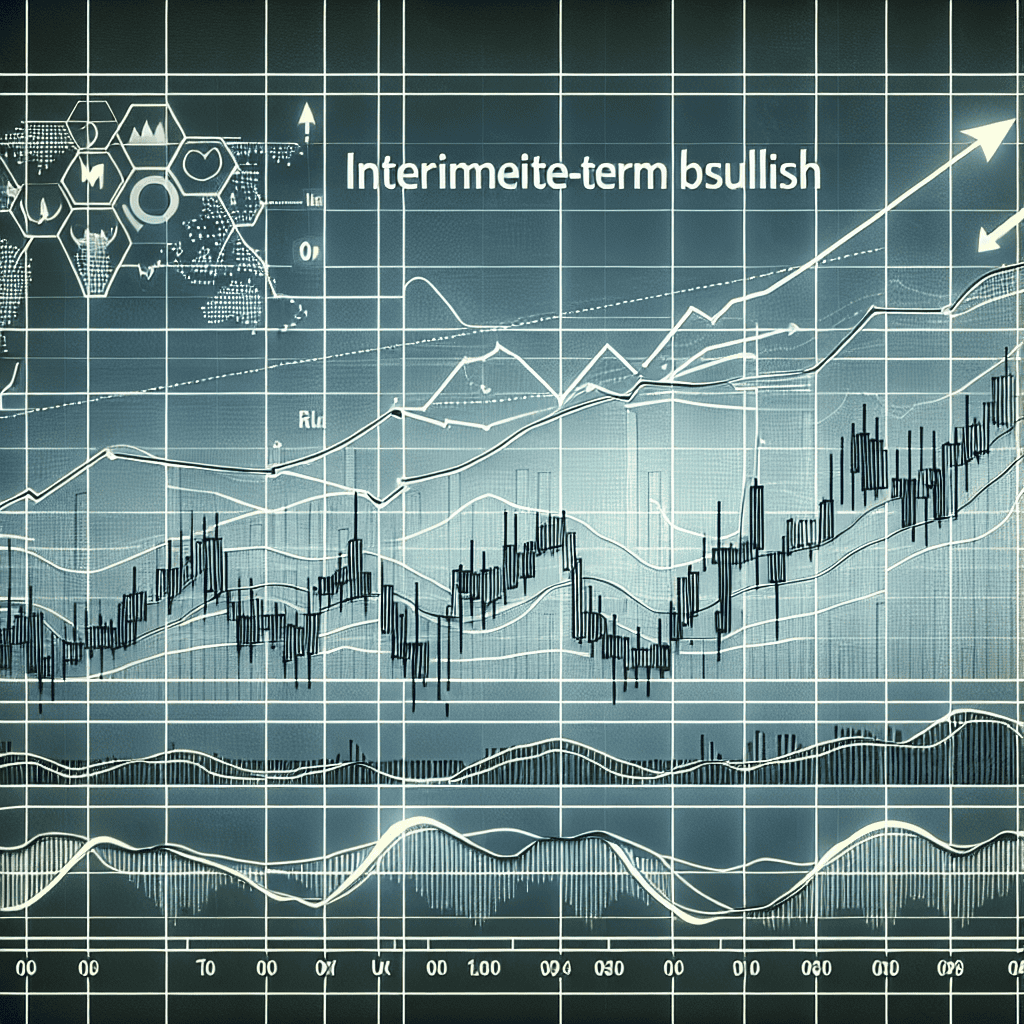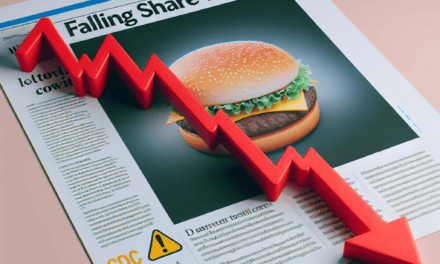“Riding the Wave: Navigating the Intermediate-Term Bullish Horizon with Technical Precision”
Introduction
Intermediate-term bullish outlook in technical analysis refers to a positive expectation for asset prices over a medium time frame, typically ranging from a few weeks to several months. This perspective is derived from analyzing chart patterns, trend lines, and various technical indicators that suggest upward momentum. Traders and investors look for signals such as moving average crossovers, support and resistance levels, and bullish candlestick formations to identify potential buying opportunities. The intermediate-term outlook is crucial for those seeking to capitalize on market trends without the short-term volatility or the long-term uncertainties, providing a balanced approach to investment strategies.
Understanding Intermediate-Term Bullish Patterns in Technical Analysis
In the realm of financial markets, technical analysis serves as a crucial tool for investors and traders seeking to understand price movements and forecast future trends. Among the various timeframes considered in technical analysis, the intermediate-term outlook often garners significant attention due to its balance between short-term volatility and long-term trends. An intermediate-term bullish outlook, in particular, can provide valuable insights into potential upward movements in asset prices, offering opportunities for strategic investment decisions.
To comprehend intermediate-term bullish patterns, it is essential to first recognize the indicators and chart patterns that signal such trends. Moving averages, for instance, are a fundamental component of technical analysis, often used to smooth out price data and identify the direction of a trend. When a shorter-term moving average crosses above a longer-term moving average, it generates a bullish signal known as a “golden cross.” This pattern suggests that upward momentum is building, potentially leading to sustained price increases over the intermediate term.
In addition to moving averages, other technical indicators such as the Relative Strength Index (RSI) and the Moving Average Convergence Divergence (MACD) can further validate a bullish outlook. The RSI, which measures the speed and change of price movements, can indicate overbought or oversold conditions. An RSI value above 70 typically suggests that an asset is overbought, yet in the context of a strong bullish trend, it may also indicate continued upward momentum. Similarly, the MACD, which tracks the relationship between two moving averages, can provide bullish signals when the MACD line crosses above the signal line, reinforcing the potential for price appreciation.
Moreover, chart patterns play a pivotal role in identifying intermediate-term bullish trends. Patterns such as ascending triangles, cup and handle formations, and inverse head and shoulders are classic bullish patterns that suggest a continuation or reversal of a trend. An ascending triangle, characterized by a horizontal resistance line and an upward-sloping support line, indicates that buyers are gradually gaining strength, often leading to a breakout above resistance. Similarly, a cup and handle pattern, which resembles the shape of a teacup, signifies a period of consolidation followed by a breakout, suggesting a bullish continuation.
While these indicators and patterns provide valuable insights, it is crucial to consider the broader market context when evaluating an intermediate-term bullish outlook. Economic indicators, geopolitical events, and market sentiment can all influence price movements, potentially altering the trajectory of a trend. Therefore, integrating technical analysis with fundamental analysis can offer a more comprehensive view, allowing investors to make informed decisions.
Furthermore, risk management remains a critical aspect of trading and investing, even when a bullish outlook is anticipated. Setting stop-loss orders and determining appropriate position sizes can help mitigate potential losses in the event of unexpected market reversals. By balancing technical insights with prudent risk management strategies, investors can better navigate the complexities of financial markets.
In conclusion, understanding intermediate-term bullish patterns in technical analysis involves recognizing key indicators and chart patterns that signal potential upward trends. By combining these technical insights with an awareness of broader market conditions and effective risk management, investors can enhance their ability to capitalize on opportunities within the financial markets. As always, continuous learning and adaptation remain essential in the ever-evolving landscape of trading and investing.
Key Indicators Signaling a Bullish Outlook
In the realm of financial markets, technical analysis serves as a crucial tool for investors seeking to understand and predict market trends. As we delve into the intermediate-term bullish outlook, several key indicators emerge, signaling potential upward momentum in the market. These indicators, when analyzed collectively, provide a comprehensive view of the market’s current state and its likely trajectory.
To begin with, moving averages are fundamental in technical analysis, offering insights into market trends over various time frames. The 50-day and 200-day moving averages are particularly significant. When the 50-day moving average crosses above the 200-day moving average, it forms what is known as a “golden cross,” a classic bullish signal. This crossover suggests that the market’s short-term momentum is gaining strength relative to its longer-term trend, often preceding a sustained upward movement. Observing this pattern in the current market context reinforces the intermediate-term bullish outlook.
In addition to moving averages, the Relative Strength Index (RSI) is another pivotal indicator. The RSI measures the speed and change of price movements, oscillating between zero and 100. An RSI above 70 typically indicates that a security is overbought, while an RSI below 30 suggests it is oversold. In the present scenario, many securities are approaching the overbought threshold, yet they remain within a range that suggests continued bullish momentum. This indicates that while the market is experiencing strong buying pressure, it has not yet reached an unsustainable level, thereby supporting the bullish outlook.
Furthermore, the analysis of volume trends provides additional confirmation of market sentiment. Volume, the number of shares or contracts traded in a security or market, is a critical component of technical analysis. An increase in volume accompanying a price rise suggests strong investor confidence and commitment to the current trend. In recent weeks, there has been a noticeable uptick in trading volume, particularly during upward price movements. This surge in volume underscores the market’s bullish sentiment, as it reflects a robust participation rate among investors who are optimistic about future price increases.
Moreover, the examination of market breadth offers further insights into the market’s health. Market breadth refers to the number of stocks advancing relative to those declining. A broad-based rally, where a significant majority of stocks are participating in the upward movement, is a strong indicator of a healthy bull market. Currently, market breadth indicators reveal a positive trend, with a substantial proportion of stocks showing gains. This widespread participation suggests that the bullish sentiment is not confined to a few sectors but is rather a market-wide phenomenon.
Finally, it is essential to consider the role of macroeconomic factors in shaping market trends. While technical indicators provide valuable insights, they do not operate in isolation. Economic data, such as employment figures, inflation rates, and central bank policies, can significantly influence market dynamics. Presently, favorable economic conditions, including steady job growth and moderate inflation, are creating a supportive backdrop for the market’s bullish trajectory.
In conclusion, the intermediate-term bullish outlook is underpinned by a confluence of technical indicators, including moving averages, RSI, volume trends, and market breadth. These indicators, when viewed in conjunction with positive macroeconomic factors, paint a compelling picture of a market poised for continued growth. As investors navigate this landscape, a thorough understanding of these key indicators will be instrumental in making informed decisions and capitalizing on emerging opportunities.
Analyzing Moving Averages for Bullish Trends
In the realm of technical analysis, moving averages serve as a fundamental tool for traders and investors seeking to identify potential bullish trends in the market. These averages, which smooth out price data by creating a constantly updated average price, are instrumental in discerning the underlying direction of an asset’s movement. By analyzing moving averages, one can gain insights into the intermediate-term bullish outlook of a particular security or market index.
To begin with, it is essential to understand the different types of moving averages commonly used in technical analysis. The two most prevalent are the simple moving average (SMA) and the exponential moving average (EMA). The SMA calculates the average of a selected range of prices, typically closing prices, over a specified period. In contrast, the EMA gives more weight to recent prices, making it more responsive to new information. Both types of moving averages have their merits, and the choice between them often depends on the trader’s preference and the specific market conditions.
When analyzing moving averages for bullish trends, one of the key indicators to observe is the crossover. A bullish crossover occurs when a shorter-term moving average crosses above a longer-term moving average. This event is often interpreted as a signal that the asset’s price is gaining upward momentum, suggesting a potential bullish trend. For instance, a common strategy involves the 50-day SMA crossing above the 200-day SMA, known as the “golden cross,” which is widely regarded as a bullish signal.
Moreover, the slope of the moving average itself can provide valuable insights into the market’s direction. An upward-sloping moving average indicates that prices are generally increasing over the selected period, reinforcing the bullish sentiment. Conversely, a downward-sloping moving average may suggest a weakening trend, prompting traders to exercise caution. By observing the angle and direction of the moving averages, investors can better gauge the strength and sustainability of a potential bullish trend.
In addition to crossovers and slopes, the relationship between the price and the moving average is another critical factor to consider. When the price consistently remains above a moving average, it is often seen as a sign of strength, indicating that the asset is in an uptrend. This scenario can bolster confidence in a bullish outlook, as it suggests that buyers are in control and are willing to pay higher prices. On the other hand, if the price frequently dips below the moving average, it may signal a lack of conviction among buyers, potentially undermining the bullish case.
Furthermore, moving averages can also serve as dynamic support and resistance levels. In an uptrend, a moving average may act as a support level, where the price tends to bounce back after testing it. This behavior can provide traders with potential entry points to capitalize on the bullish trend. Conversely, in a downtrend, a moving average may act as a resistance level, where the price struggles to break through, indicating potential selling opportunities.
In conclusion, moving averages are a vital component of technical analysis, offering valuable insights into intermediate-term bullish trends. By examining crossovers, slopes, and the relationship between price and moving averages, traders can make informed decisions about potential market movements. As with any analytical tool, it is crucial to use moving averages in conjunction with other indicators and market factors to develop a comprehensive understanding of the market’s dynamics. Through careful analysis and interpretation, moving averages can significantly enhance one’s ability to identify and capitalize on bullish opportunities in the financial markets.
The Role of Volume in Confirming Bullish Sentiment

In the realm of technical analysis, volume plays a pivotal role in confirming bullish sentiment, serving as a crucial indicator that can validate or refute price movements. As investors and traders seek to decipher the complexities of market behavior, understanding the interplay between price and volume becomes essential. Volume, the total number of shares or contracts traded for a security, provides insight into the strength or weakness of a price trend. When analyzing an intermediate-term bullish outlook, volume can offer valuable confirmation that the upward movement is supported by genuine market interest.
To begin with, a key principle in technical analysis is that volume should move in tandem with price. In a bullish scenario, as prices rise, an increase in volume suggests that more participants are buying into the trend, thereby reinforcing the upward momentum. This alignment between price and volume indicates that the trend is likely to continue, as it reflects a consensus among market participants. Conversely, if prices rise on declining volume, it may signal a lack of conviction, suggesting that the trend could be unsustainable and potentially subject to reversal.
Moreover, volume can also help identify potential turning points in the market. For instance, during a period of consolidation, where prices move within a narrow range, a sudden spike in volume accompanied by a breakout above resistance levels can serve as a strong bullish signal. This surge in volume indicates that the market has resolved its indecision, with buyers stepping in forcefully to drive prices higher. Such breakouts, confirmed by robust volume, often lead to significant price advances, as they reflect a shift in market sentiment from uncertainty to optimism.
In addition to breakouts, volume analysis can be instrumental in assessing the validity of pullbacks within an uptrend. During a healthy bullish trend, occasional pullbacks or corrections are natural and can provide opportunities for traders to enter the market at more favorable prices. However, the nature of these pullbacks can offer clues about the underlying strength of the trend. If a pullback occurs on low volume, it suggests that selling pressure is weak and that the overall bullish sentiment remains intact. On the other hand, a pullback accompanied by high volume may indicate a more significant shift in sentiment, warranting caution and further analysis.
Furthermore, volume can be used in conjunction with other technical indicators to enhance the reliability of bullish signals. For example, the On-Balance Volume (OBV) indicator, which accumulates volume based on price direction, can provide additional confirmation of a trend’s strength. A rising OBV line during an uptrend suggests that volume is supporting the price increase, reinforcing the bullish outlook. Similarly, the Volume Weighted Average Price (VWAP) can help traders identify potential entry and exit points by comparing the current price to the average price weighted by volume.
In conclusion, volume serves as a vital component in confirming bullish sentiment within an intermediate-term outlook. By analyzing the relationship between price and volume, traders and investors can gain a deeper understanding of market dynamics and make more informed decisions. Whether through confirming breakouts, assessing pullbacks, or complementing other technical indicators, volume provides a robust framework for evaluating the strength and sustainability of bullish trends. As such, incorporating volume analysis into one’s technical toolkit can significantly enhance the ability to navigate the complexities of financial markets.
Identifying Bullish Reversal Patterns
In the realm of technical analysis, identifying bullish reversal patterns is a crucial skill for traders and investors aiming to capitalize on potential upward market movements. These patterns, which signal a possible change in the prevailing downtrend, can provide valuable insights into future price action. Understanding and recognizing these patterns can significantly enhance one’s ability to make informed trading decisions.
One of the most widely recognized bullish reversal patterns is the “double bottom.” This pattern typically forms after a sustained downtrend and is characterized by two distinct troughs at approximately the same price level, separated by a peak. The double bottom suggests that the asset has found a strong support level, and the subsequent breakout above the peak, known as the “confirmation point,” indicates a potential reversal of the downtrend. Traders often look for increased volume during the breakout as a further confirmation of the pattern’s validity.
In addition to the double bottom, the “inverse head and shoulders” pattern is another powerful bullish reversal signal. This pattern consists of three troughs: a central trough (the head) that is lower than the two flanking troughs (the shoulders). The neckline, drawn by connecting the peaks between the shoulders and the head, serves as a critical level of resistance. A breakout above this neckline, accompanied by a surge in trading volume, typically confirms the reversal and suggests a shift in market sentiment from bearish to bullish.
Moreover, the “rounding bottom” pattern, also known as a “saucer bottom,” is a more gradual and prolonged reversal pattern. It is characterized by a concave shape that reflects a slow transition from a downtrend to an uptrend. This pattern often indicates a period of accumulation, where investors gradually build positions in anticipation of a future price increase. The rounding bottom is confirmed when the price breaks above the resistance level formed at the beginning of the pattern, signaling a potential long-term bullish trend.
While these patterns provide valuable insights, it is essential to consider other technical indicators and market conditions to enhance the reliability of the analysis. For instance, incorporating moving averages can help identify the overall trend direction and provide additional confirmation of a reversal. Similarly, oscillators such as the Relative Strength Index (RSI) or the Moving Average Convergence Divergence (MACD) can offer insights into the momentum and potential overbought or oversold conditions, further supporting the reversal thesis.
Furthermore, it is crucial to remain aware of broader market factors that may influence the effectiveness of these patterns. Economic data releases, geopolitical events, and changes in monetary policy can all impact market sentiment and price movements. Therefore, combining technical analysis with a comprehensive understanding of the macroeconomic environment can provide a more holistic view of potential market reversals.
In conclusion, identifying bullish reversal patterns is an essential component of technical analysis that can offer significant opportunities for traders and investors. By recognizing patterns such as the double bottom, inverse head and shoulders, and rounding bottom, and by integrating additional technical indicators and market context, one can enhance their ability to anticipate and capitalize on potential bullish trends. As with any analytical approach, maintaining a disciplined and informed perspective is key to navigating the complexities of financial markets successfully.
Using Fibonacci Retracements to Predict Bullish Movements
In the realm of technical analysis, Fibonacci retracements serve as a pivotal tool for traders and analysts aiming to predict potential bullish movements in the market. This method, rooted in the mathematical principles discovered by Leonardo Fibonacci, involves identifying potential reversal levels by measuring the prior price movement. By applying Fibonacci retracement levels to a price chart, traders can identify key support and resistance levels, which are crucial for making informed trading decisions.
To begin with, Fibonacci retracements are based on the idea that markets will retrace a predictable portion of a move, after which they will continue in the original direction. The most commonly used retracement levels are 23.6%, 38.2%, 50%, 61.8%, and 100%. These levels are derived from the Fibonacci sequence, where each number is the sum of the two preceding ones, leading to the golden ratio of 1.618, or its inverse, 0.618. This ratio is believed to have a significant impact on market behavior, as it appears frequently in natural phenomena and human psychology.
In practice, traders apply these retracement levels to a chart by identifying a significant price movement, either upward or downward, and then dividing the vertical distance by the key Fibonacci ratios. For instance, if a stock price rises from $100 to $150, a 38.2% retracement would suggest a potential support level around $130.90. This level becomes a focal point for traders, as it may indicate where the price could find support before resuming its upward trajectory.
Moreover, the application of Fibonacci retracements is not limited to identifying support levels. They can also be used to pinpoint resistance levels in a downtrend. When a market is in a bearish phase, traders look for retracement levels to identify potential points where the price might reverse and continue its downward trend. This dual functionality makes Fibonacci retracements a versatile tool in the technical analyst’s arsenal.
Transitioning to the intermediate-term bullish outlook, Fibonacci retracements can be particularly useful in identifying potential entry points for traders looking to capitalize on upward market movements. By analyzing past price movements and applying Fibonacci levels, traders can anticipate where the market might find support and prepare to enter positions at these strategic points. This approach not only aids in maximizing potential gains but also helps in managing risk by setting stop-loss orders just below these key levels.
Furthermore, combining Fibonacci retracements with other technical indicators can enhance their predictive power. For instance, when a Fibonacci level coincides with a moving average or a trendline, it strengthens the likelihood of that level acting as a significant support or resistance. This confluence of indicators provides traders with greater confidence in their analysis and decision-making process.
In conclusion, Fibonacci retracements offer a systematic approach to predicting bullish movements in the market. By identifying key support and resistance levels, traders can make informed decisions about when to enter or exit positions. While no tool can guarantee success, the strategic application of Fibonacci retracements, especially when combined with other technical indicators, can significantly enhance a trader’s ability to navigate the complexities of the financial markets. As such, they remain an indispensable component of technical analysis, providing valuable insights into potential market behavior and aiding traders in their pursuit of profitable opportunities.
The Impact of Market Sentiment on Intermediate-Term Bullish Trends
Market sentiment plays a pivotal role in shaping intermediate-term bullish trends, acting as a barometer for investor confidence and market dynamics. Understanding the nuances of market sentiment is crucial for investors and analysts who seek to predict and capitalize on bullish trends. As market sentiment shifts, it influences the collective behavior of investors, thereby impacting price movements and trend formations. In this context, technical analysis emerges as a valuable tool, offering insights into how sentiment-driven actions manifest in market patterns and indicators.
To begin with, market sentiment is often gauged through various indicators such as the put-call ratio, the volatility index (VIX), and sentiment surveys. These indicators provide a snapshot of investor mood, whether it be fear, optimism, or neutrality. For instance, a low put-call ratio may indicate bullish sentiment, as investors are purchasing more calls than puts, anticipating upward price movements. Similarly, a declining VIX suggests reduced market volatility and increased investor confidence, often preceding or accompanying bullish trends. By analyzing these indicators, investors can infer the prevailing sentiment and adjust their strategies accordingly.
Moreover, technical analysis offers a framework for interpreting how sentiment influences price action. Chart patterns, such as ascending triangles or bullish flags, often emerge during periods of positive sentiment, signaling potential continuation of upward trends. Moving averages, another staple of technical analysis, can also reflect sentiment shifts. When short-term moving averages cross above long-term ones, it often indicates a bullish crossover, suggesting that sentiment is turning positive. These technical signals, when aligned with sentiment indicators, provide a robust basis for predicting intermediate-term bullish trends.
In addition to these tools, volume analysis serves as a critical component in understanding sentiment’s impact on market trends. High trading volumes during price increases typically signify strong bullish sentiment, as more participants are willing to buy at higher prices. Conversely, low volumes during price rises may indicate a lack of conviction, suggesting that the bullish trend might be short-lived. Therefore, analyzing volume patterns alongside price movements can offer deeper insights into the strength and sustainability of bullish trends.
Furthermore, the interplay between market sentiment and external factors such as economic data releases, geopolitical events, and corporate earnings reports cannot be overlooked. Positive economic indicators, for instance, can bolster investor confidence, reinforcing bullish sentiment and driving prices higher. Similarly, favorable earnings reports can trigger optimism, leading to increased buying activity and the formation of bullish trends. Technical analysis can help identify these sentiment-driven reactions by highlighting breakout patterns or support and resistance levels that are breached following such events.
In conclusion, the impact of market sentiment on intermediate-term bullish trends is profound and multifaceted. By leveraging technical analysis, investors can gain a clearer understanding of how sentiment influences market behavior and price dynamics. Through the careful examination of sentiment indicators, chart patterns, moving averages, and volume analysis, investors can better anticipate and navigate bullish trends. Additionally, considering the influence of external factors on sentiment can further enhance the accuracy of trend predictions. Ultimately, a comprehensive approach that integrates sentiment analysis with technical tools can empower investors to make informed decisions and optimize their strategies in pursuit of intermediate-term gains.
Q&A
1. **What is an Intermediate-Term Bullish Outlook?**
An intermediate-term bullish outlook refers to a positive expectation for the price movement of a security or market over a medium time frame, typically ranging from a few weeks to several months.
2. **What technical indicators are commonly used to identify an intermediate-term bullish outlook?**
Common technical indicators include moving averages (such as the 50-day and 200-day moving averages), the Relative Strength Index (RSI), MACD (Moving Average Convergence Divergence), and trendlines.
3. **How does the moving average crossover signal a bullish outlook?**
A bullish crossover occurs when a shorter-term moving average crosses above a longer-term moving average, indicating potential upward momentum.
4. **What role does volume play in confirming a bullish outlook?**
Increased trading volume during price advances can confirm a bullish outlook, as it suggests strong investor interest and conviction in the upward movement.
5. **How can trendlines be used to support a bullish outlook?**
An upward-sloping trendline connecting higher lows can indicate a sustained bullish trend, providing support levels for potential price pullbacks.
6. **What is the significance of the Relative Strength Index (RSI) in a bullish outlook?**
An RSI value above 50 typically suggests bullish momentum, while values above 70 may indicate overbought conditions, potentially signaling a pullback.
7. **How can chart patterns indicate an intermediate-term bullish outlook?**
Bullish chart patterns, such as ascending triangles, cup and handle formations, or inverse head and shoulders, can signal potential upward breakouts and continuation of a bullish trend.
Conclusion
The intermediate-term bullish outlook, based on technical analysis, suggests a favorable market trend characterized by rising prices and positive momentum indicators. Key technical patterns, such as ascending triangles or bullish flags, alongside moving averages trending upwards, support this optimistic perspective. Additionally, volume analysis may reveal increased buying interest, further reinforcing the bullish sentiment. However, it is crucial to remain vigilant for potential resistance levels and external market factors that could alter this trajectory. Overall, the technical indicators align to project continued upward movement in the intermediate term, warranting a cautiously optimistic investment approach.





